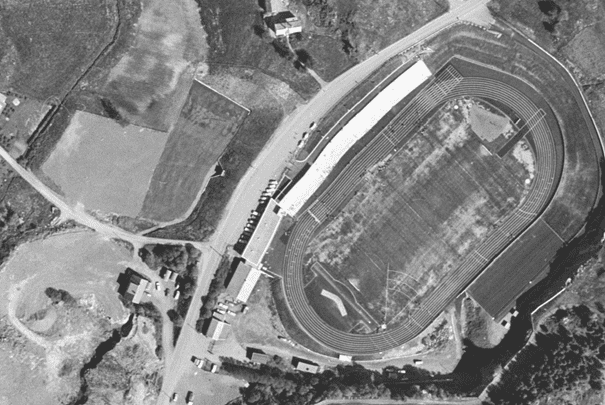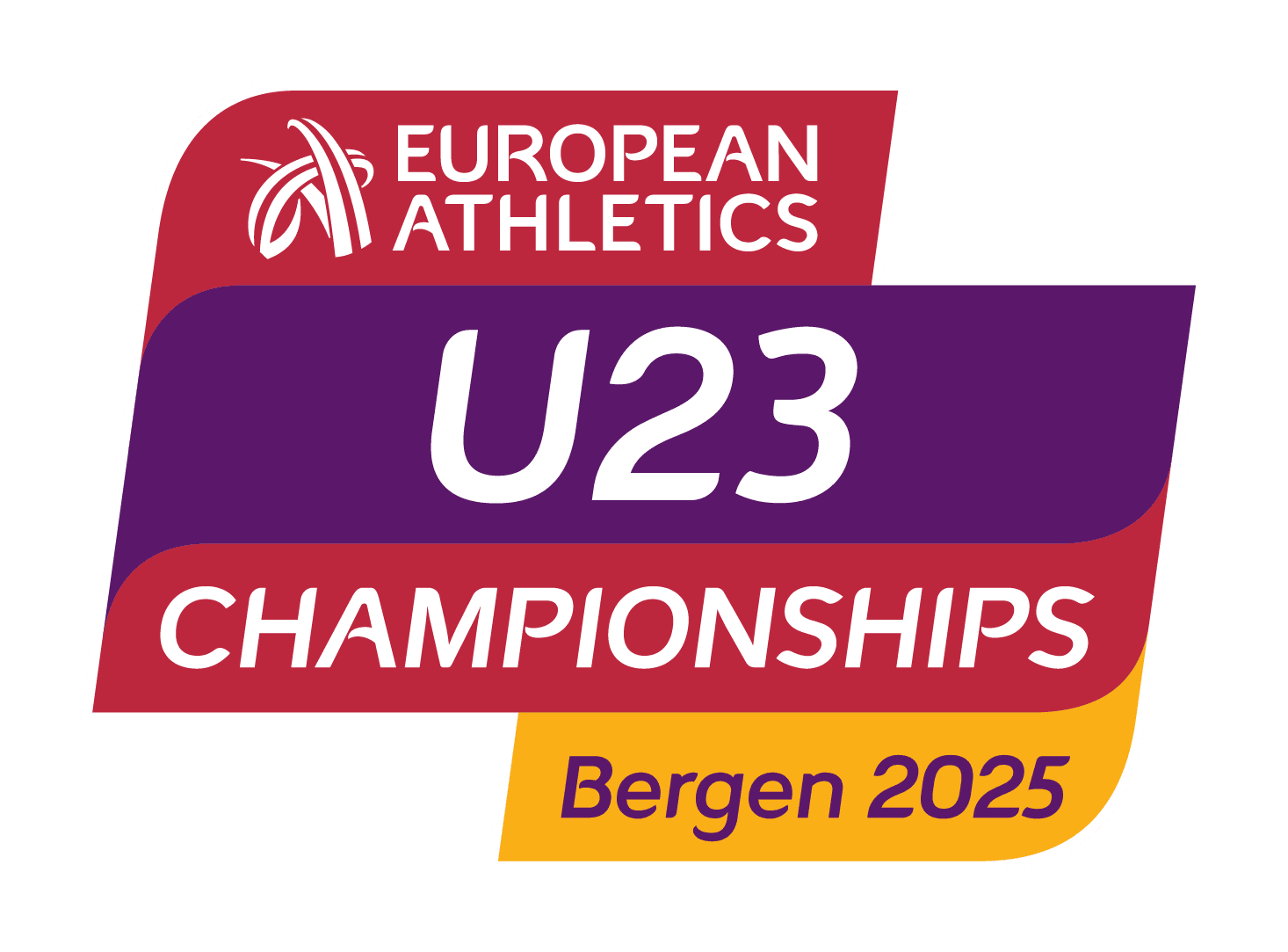History of Fana stadium
Planning and construction phase 1962-1969
In 1962 the municipal council in former Fana Municipality decided that the future central sports facility shall be located at the property of Fana Stone Crusher Facility. The architect, Martin Henriksen was assigned to the project in 1964 and you can see the draft plan on the picture below. Where the stadium is shown, lay the gravel outlet. The construction work started in 1966 and was completed in 1969.
The Fana Municipality was truly farsighted and visionary. Here is a description of the project:
– In the work on the facility, emphasis has been placed on ensuring that the young athletes will receive a quality facility that will meet today’s and possibly tomorrow’s requirements. Construction of the track with a minimum of 2m of stone filling on mountain ground makes the track as strong as a motorway. 400m running track with 8 lanes and rubber asphalt surface – gravel pad with heating cables under the football field’s grass carpet, so far no other stadium in the country has this. Modern lighting and loudspeaker systems and cloakrooms equipped with showers, saunas and sanitary facilities, as well as meeting offices, are also among the things worth highlighting.
– From the changing rooms, there is, in addition to close contact with the stadium, a tunnel connection under the Grimseidvegen to the jogging and training field located on the west side of the road. The facility will have changing room capacity for a maximum of 200 athletes. However, additional changing rooms can be established at a nearby school.
– In the first stage of construction, the stadium will be equipped with seating stands for 2,500 people on the western long side. There will be standing areas on the slope on the opposite side, and it is estimated that around 7,500 spectators can be placed here. The conditions are well suited for further development of the grandstand capacity and if organizers and sports champions can convince the authorities that there is a need for further development, there will hardly be any technical or site-related difficulties in building stands for 20,000-30,000 spectators.
From rubber asphalt to synthetic surface 1969-1978
Fana stadium was officially opened at the major Norwegian Championships 15-17. August 1969. It definitely was the first modern 400m rubber asphalt track in Norway with 8 lanes.

Fana stadium in 1970
The Fana Municipality became part of Bergen Municipality in 1972 and since Bergen did not have any track and field stadium at the same level and quality as Fana, it was easy for Bergen to dedicate Fana stadium as the main arena for the big athletics meetings.
The experience with the rubber asphalt was not the best. When the Norwegian Championships was back in Fana in August 1975 it was very warm weather which caused that the rubber asphalt track became very soft. In 1971 the Bislett Stadium in Oslo got synthetic surface and in 1976 another track in Oslo (Stovner) had the same. There was no doubt that if you wanted to set personal bests, the synthetic surfaces tracks gave much higher performances than rubber asphalt. Fortunately, the athletes in Bergen did not have to wait so long for the synthetic surface revolution. In 1978 Fana stadium was upgraded with artificial all-weather running surface.
Further facility enhancements 1979-2025
With the new synthetic track surface the meeting organizers in Bergen got the possibility to apply for international events. You can read more about that in the next section.
In this period until today, enhancements have further developed the stadium due to higher requirements for hosting international meetings and championships.
In 1985 the indoor tunnel called Høiehallen opened with 110m synthetic track (6 lanes) and facilities for long jump, triple jump, pole vault, high jump and shot put. This indoor tunnel located at the southern end of the stadium is mainly used for winter training, but it is normally utilized as call room and warmup area for the big outdoor meetings.
Before the Bergen Bislett Games in 2004 a new stand was established outside the bend in the northern end of the track and later before the European Team Championships in 2010 a new stand was established outside the bend in the southern end of the track.
In 2019 the stadium facilities for the field events were extended with 2 more pits for horizontal jumps, 1 additional field for pole vault and 1 extra shut put circle. Because of this extension, football matches cannot anymore be played on Fana stadium.
In May 2025 the new Gneist Indoor Arena with a 200m circular running track (6 lanes) next to Fana stadium is going to be ready. Also in 2025 the existing gravel warmup area outside the stadium for discus and hammer throw will be extended with a circle for shut put.
Fana stadium, Høiehallen and the warm-up field are owned by Bergen Municipality. The new Gneist Indoor Arena will be owned by the local sports club Gneist.
National matches
1979 National match Norway-Australia (race walking only)
1980 National match Norway-Greece (men)-West Germany (women)
Nordic matches
1990 Nordic match juniors
1999 Nordic match juniors (race walking only)
2001 Proffice Nordic Challenge (Norway-Finland-Sweden)
2004 Nordic match (Norway-Finland-Sweden)
2008 Nordic match juniors
Søfteland Grand Prix
race walking
Bergen Bislett Games
one of the highlights was the IAAF Golden League Bergen Bislett Games in 2004 when the famous arena in Oslo was under full reconstruction.
European Team Championships
1996 European Cup 1.league
2009 European Team Championships 1. league
2010 European Team Championships Super league
Trond Mohn Games
2019-2024, except 2020
Norwegian Championships
The major Norway Championships took place at Fana stadium in 1969, 1975, 1991, 2005 and 2020. Here are the winners of the King´s throphies:
1969: Arne Kvalheim (1500m men 3,42,3) and Britt Ramstad (800m woman 2,08,1).
1975: Knut Børø (5000m men 13,34,2) and legendary Grete Waitz (1500m women 4,11,3).
1991: The present director of Bislett Games Steinar Hoen (high jump men 2,29) and legendary Trine Hattestad (javelin women 71,44).
2005: The legendary Andreas Thorkildsen (javelin men 83,63) and Susanne Wigene (5000m women 15,01,05).
2020: Jacob Asserson Ingebrigtsen (1500m men 3,33,93) and Amalie Iuel (400m hurdles women 55,63).
International single meetings
In 1981 one of the greatest sprinters and long jumpers in the previous century, Carl Lewis from USA, won the 100m in 10,4 manual time. His world lead time that year was 10,00.
World lead at the same year at 400m for men, Bert Cameron, Jamaica ran the 200m in 20,9 manual time.
World top 2 in discus for men in 1981, Ben Pluckett, USA and teammate John Powell, USA were beaten by their Norwegian rival, Knut Hjeltnes, who won the competition with 65,98m.
In javelin, Bog Roggy, USA, achieved 88,88m, the longest javelin-throw ever at Fana stadium, but with the old javelin type that was discontinued in 1999.

